Overview
A History of Impacts
Patterns of land and water use in the Gulf of Maine region over hundreds of years have changed the structure and functioning of watersheds and nearshore systems. Coastal wetland decline and impaired tidal flow is commonplace, the spread of invasive species is increasing, and dams and road systems in the region block fish and wildlife access to important habitats. Together, these changes imperil jobs linked to the natural resource based economy like fisheries and tourism, impair land values, cause fish and wildlife declines and erode our quality of life.
What Restoration Achieves
Habitat restoration returns natural systems to ecologically diverse and economically supportive conditions. Restoration restores fish and wildlife populations, coastal wetlands that protect communities from sea level rise and increasingly intense storms, and re-establishes conditions that support fisheries and tourism. Restoration uses proven, commonsense approaches that return successful results like any other well-planned construction project.
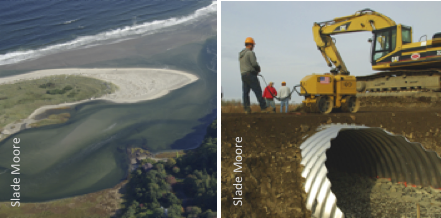
Restoration improves habitats (left), which are critical to tourism and fishing industries. Restoration projects can’t be outsourced, so they help local economies by employing the local workforce (right). Three different types of jobs are created or sustained by restoration projects:
Benefits to People and the Environment
Whether it’s the restoration of tidal flow to coastal wetlands, removal of deteriorating dams, or construction of fishways, restoration addresses more than ecological concerns. Projects remove public safety hazards, lessen road maintenance costs, enhance commercial and recreational fishing opportunities, and also encourage more restoration at the local scale. Most restoration projects rely on engineering, construction labor, equipment and materials sourced from the local community, home state or province, so most restoration dollars stay local. Restoration’s job creation impacts often exceed other industrial sectors.
Jobs created per $1 million invested: Habitat restoration ranks highly among traditional sectors1
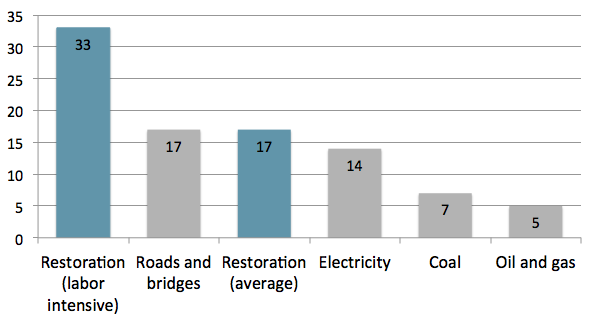
1 Edwards, P.E.T., A.E Sutton-Grier and G.E Coyle. 2012. Investing in Nature: Restoring Coastal Habitat, Blue Infrastructure, and Green Job Creation. Marine Policy.
GOMC’s Regional Restoration Impacts
Since 2002, the Gulf of Maine Council on the Marine Environment (GOMC) has provided grants and technical assistance to over 120 restoration projects in Maine, Massachusetts, New Hampshire, New Brunswick and Nova Scotia. Working with partners and donors like NOAA, Corporate Wetlands Restoration Partnership, Royal Bank of Canada, Mass DER, NH DES, Maine SPO and DOT, Canada DFO, and the Jessie B. Cox Charitable Trust, these projects returned impaired tidal marshes, shellfish flats, and streams to diverse, productive natural systems. GOMC Restoration’s efficient deployment of technical support teams and its administrative consistently leads to successful project outcomes that maximize the impact of each restoration investment.
GOMC projects by jurisdiction (Total = 120)
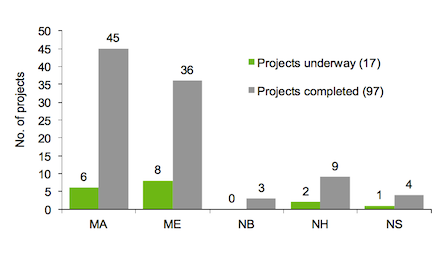
Habitats restored with GOMC physical restoration funding
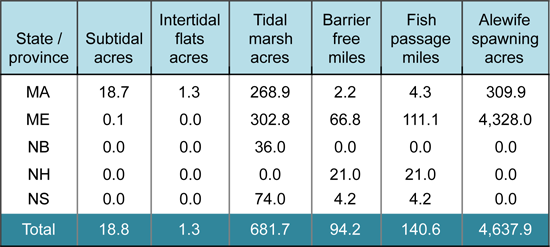
Habitats Restored
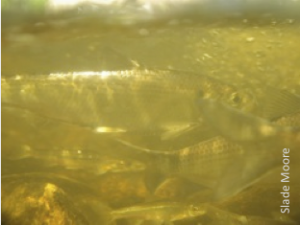 GOMC’s support for 120 on-the-ground projects has re-established tidal flow in 682 tidal marsh acres, provided 94 barrier-free stream miles, renewed fish passage in 141 stream miles, and restored alewife access to 4,638 acres of spawning habitat. Our funding for regional assessments and the planning stages of on-the-ground projects have resulted in positioning many more projects throughout the Gulf for successful restoration. In addition to the species mentioned, at risk sea-run fish like Atlantic salmon, rainbow smelt, American eels and highly prized resident gamefish like wild eastern brook trout all benefit from our work. Above all, GOMC seeks to re-establish natural processes that create and maintain habitat long after projects have ended.
GOMC’s support for 120 on-the-ground projects has re-established tidal flow in 682 tidal marsh acres, provided 94 barrier-free stream miles, renewed fish passage in 141 stream miles, and restored alewife access to 4,638 acres of spawning habitat. Our funding for regional assessments and the planning stages of on-the-ground projects have resulted in positioning many more projects throughout the Gulf for successful restoration. In addition to the species mentioned, at risk sea-run fish like Atlantic salmon, rainbow smelt, American eels and highly prized resident gamefish like wild eastern brook trout all benefit from our work. Above all, GOMC seeks to re-establish natural processes that create and maintain habitat long after projects have ended.
Gulf-Wide Restoration Leadership
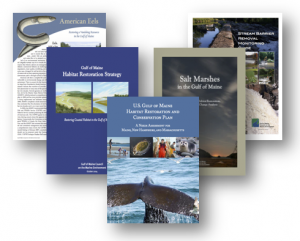 In addition to supporting the planning and implementation of on-the-ground projects, GOMC’s development of restoration tools, methods, outreach and regional strategies increases awareness of habitat needs and promotes the use of rigorous practices for restoring them. GOMC’s role as a regional leader and partner in habitat restoration maximizes its presence and effectiveness.
In addition to supporting the planning and implementation of on-the-ground projects, GOMC’s development of restoration tools, methods, outreach and regional strategies increases awareness of habitat needs and promotes the use of rigorous practices for restoring them. GOMC’s role as a regional leader and partner in habitat restoration maximizes its presence and effectiveness.
For more information about GOMC’s Habitat Restoration Program, contact slade.moore@bioconserve.net or visit our webpage at www.gulfofmaine.org.
GOMC Project Highlights
Massachusetts – Newman Road Salt Marsh Restoration, Newbury
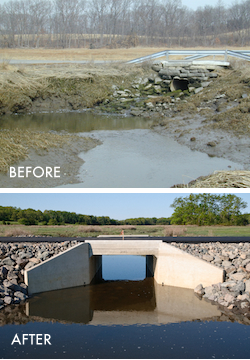 The Newman Road crossing of a tidal tributary to the Little River in Newbury dates back at least to the 1890’s and possibly to the early days of salt marsh haying. In recent times, the undersized and perched culvert restricted the flow of incoming tide, limited passage of migratory fish, encouraged colonization of invasive plant species and caused severe roadside erosion and scouring. With funding and support from a variety of donors, including a GOMC-NOAA $60,000 contribution, the Town of Newbury replaced the existing crossing with a 6-foot x 12-foot box culvert that was sized to support stream and wetland process and addressed all the previous crossings’ impacts. The North American Wetlands Conservation Act, Essex County Greenbelt Association, Mass DER, Restore America’s Estuaries, Conservation Law Foundation, Town of Newbury, NOAA Restoration Center, U.S. Fish and Wildlife Service, Massachusetts Corporate Wetlands Restoration Partnership and The Trustees of Reservations all provided key project contributions.
The Newman Road crossing of a tidal tributary to the Little River in Newbury dates back at least to the 1890’s and possibly to the early days of salt marsh haying. In recent times, the undersized and perched culvert restricted the flow of incoming tide, limited passage of migratory fish, encouraged colonization of invasive plant species and caused severe roadside erosion and scouring. With funding and support from a variety of donors, including a GOMC-NOAA $60,000 contribution, the Town of Newbury replaced the existing crossing with a 6-foot x 12-foot box culvert that was sized to support stream and wetland process and addressed all the previous crossings’ impacts. The North American Wetlands Conservation Act, Essex County Greenbelt Association, Mass DER, Restore America’s Estuaries, Conservation Law Foundation, Town of Newbury, NOAA Restoration Center, U.S. Fish and Wildlife Service, Massachusetts Corporate Wetlands Restoration Partnership and The Trustees of Reservations all provided key project contributions.
Photos: Georgeann Keer
Maine – Kennebec, Sagadahoc and Penobscot County Barrier Surveys
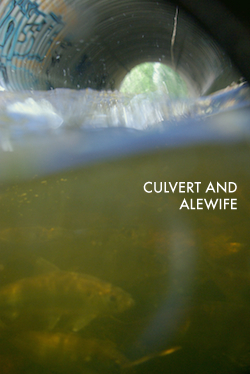 Stream restoration in Maine has often focused on dam removal or installation of fish passage structures where dam removals are not feasible. Three GOMC-NOAA Partnership grant awards totaling $94,536 helped fund surveys of nearly 3,000 road crossings, demonstrating that over 40% of Maine’s culvert crossings are barriers to resident stream organisms, long-distance migrants like river herring, and the processes that create and maintain habitat. Knowledge on the amount of stream habitat blocked by culverts is now informing restoration strategies under development in Maine. Led by the Maine Forest Service and Kennebec County Soil and Water Conservation District, other key contributors were: Kennebec Estuary Land Trust, Maine Bureau of Public Lands, Maine Department of Marine Resources, Sheepscot River Watershed Council and U.S. Fish and Wildlife Service.
Stream restoration in Maine has often focused on dam removal or installation of fish passage structures where dam removals are not feasible. Three GOMC-NOAA Partnership grant awards totaling $94,536 helped fund surveys of nearly 3,000 road crossings, demonstrating that over 40% of Maine’s culvert crossings are barriers to resident stream organisms, long-distance migrants like river herring, and the processes that create and maintain habitat. Knowledge on the amount of stream habitat blocked by culverts is now informing restoration strategies under development in Maine. Led by the Maine Forest Service and Kennebec County Soil and Water Conservation District, other key contributors were: Kennebec Estuary Land Trust, Maine Bureau of Public Lands, Maine Department of Marine Resources, Sheepscot River Watershed Council and U.S. Fish and Wildlife Service.
New Brunswick – Kennebecasis River Assessment and Restoration
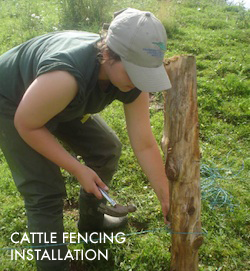 In 2009 the Kennebecasis Watershed Restoration Committee used a $19,000 GOMC-NOAA grant to initiate habitat assessments, monitoring, and restoration of sites chronically disturbed by roaming cattle. Findings of the assessments and monitoring informed restoration actions warranted at these sites. On Thompson Brook, crews fenced 603 meters of stream to prevent cattle access. Field crews also planted 430 tree and shrubs, which facilitated establishment of 3,015 m2 of a streamside vegetated buffer that will protect water quality and aquatic habitat. Other key contributors to the project included the NB Environmental Trust Fund, NB Wildlife Trust Fund, NB Student Employment and Experience Program, Canada Summer Jobs program, Sussex Fish and Game Association.
In 2009 the Kennebecasis Watershed Restoration Committee used a $19,000 GOMC-NOAA grant to initiate habitat assessments, monitoring, and restoration of sites chronically disturbed by roaming cattle. Findings of the assessments and monitoring informed restoration actions warranted at these sites. On Thompson Brook, crews fenced 603 meters of stream to prevent cattle access. Field crews also planted 430 tree and shrubs, which facilitated establishment of 3,015 m2 of a streamside vegetated buffer that will protect water quality and aquatic habitat. Other key contributors to the project included the NB Environmental Trust Fund, NB Wildlife Trust Fund, NB Student Employment and Experience Program, Canada Summer Jobs program, Sussex Fish and Game Association.
New Hampshire – Exeter River Great Dam Removal Impact Feasibility Study, Exeter
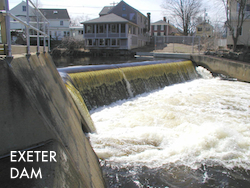 Much like other dams, the Exeter River Great Dam has long-generated concerns about public safety, flooding, and both ecological and economic considerations. The dam provides an alternate water supply and recreation area, but upstream fish passage is limited and downstream fish passage is not provided. Also a concern, the Dam’s impounded waters are impaired due to low dissolved oxygen levels. The deteriorated condition of the dam and its predicted inability to safely pass 50-year storm flows also warrants concern. To meet safety standards, the Town would need to modify the existing dam at considerable cost and then commit to a long-term maintenance investment.
Much like other dams, the Exeter River Great Dam has long-generated concerns about public safety, flooding, and both ecological and economic considerations. The dam provides an alternate water supply and recreation area, but upstream fish passage is limited and downstream fish passage is not provided. Also a concern, the Dam’s impounded waters are impaired due to low dissolved oxygen levels. The deteriorated condition of the dam and its predicted inability to safely pass 50-year storm flows also warrants concern. To meet safety standards, the Town would need to modify the existing dam at considerable cost and then commit to a long-term maintenance investment.
As a result of these concerns, citizens voted to partially support a study that would allow them to make a well-informed decision about the dam’s future. In 2010, the GOMC-NOAA Habitat Restoration Partnership contributed $40,000 to a feasibility study and impact analysis. Along with the Town of Exeter, key project partners include The New Hampshire DES’s Dam Bureau and Watershed Assistance Section, NOAA Restoration Center, US Fish and Wildlife Service, and New Hampshire Fish and Game Department.
Nova Scotia – Clementsport Dam Planning and Removal, Cornwallis
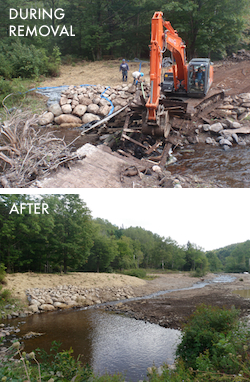 The Clementsport Dam was originally built about 70 years ago to create a drinking water supply for the community of Cornwallis. Upon construction of the Dam, upstream fish passage to most of the river’s 7.8 miles was blocked. No longer used as a water supply, the dam fell into disrepair and high river flows dislodged large portions of the wooden and stone structure. Amid concerns for public safety, an engineering review confirmed that the dam was unsafe and at risk of failure.
The Clementsport Dam was originally built about 70 years ago to create a drinking water supply for the community of Cornwallis. Upon construction of the Dam, upstream fish passage to most of the river’s 7.8 miles was blocked. No longer used as a water supply, the dam fell into disrepair and high river flows dislodged large portions of the wooden and stone structure. Amid concerns for public safety, an engineering review confirmed that the dam was unsafe and at risk of failure.
With no known owner of the dam and at the urging of the local community, the Clean Annapolis River Project initiated a three-phase project to explore and plan removal of the structure using a $61,572 grant and technical assistance form the GOMC-NOAA Partnership. Completion of the planning phase paved the way for removal of the dam, which GOMC-NOAA supported with a GOMC-NOAA restoration grant of $72,560. Habitat access for Atlantic salmon and resident species is now re-established. Along with GOMC’s Restoration Program, key project partners included NOAA, Fisheries and Oceans Canada, NS Department of Environment, NS Department of Transportation and Infrastructure Renewal, Royal Canadian Legion (Clementsport Branch), Municipality of Annapolis County, Nova Scotia Salmon Association, Atlantic Salmon Conservation Foundation, Atlantic Salmon Federation and NSLC Adopt-a-Stream Program.













